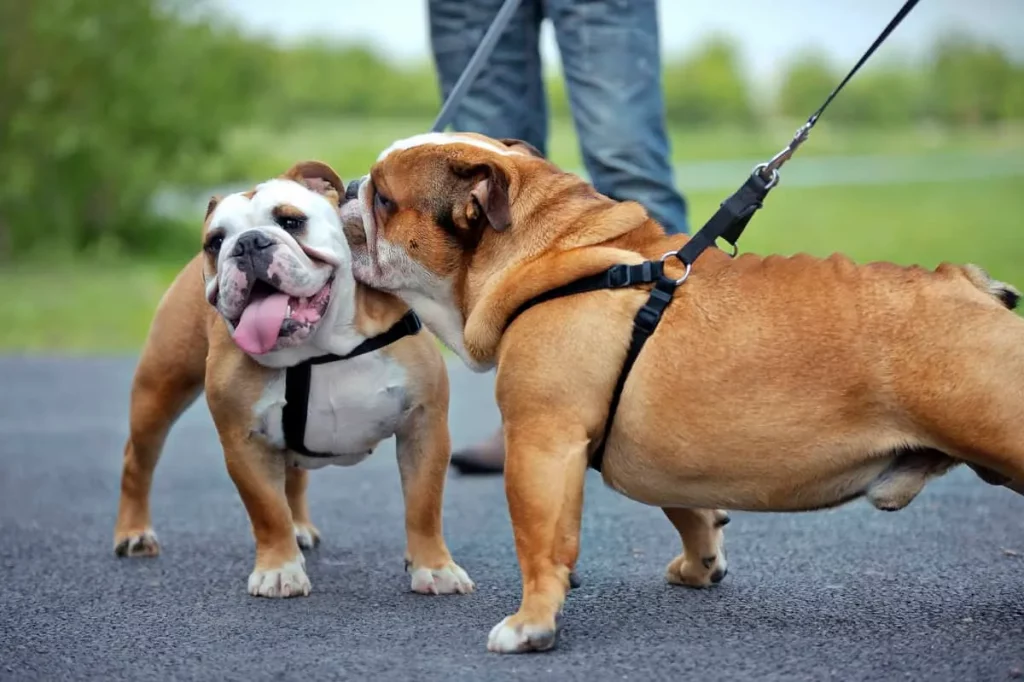How to Stop English Bulldog Biting [English Bulldog Bite Force]
English Bulldogs are known for their charming personalities and lovable faces, but they may sometimes display unwanted behaviors such as biting. In this article, we’ll explore effective methods to teach your English Bulldog not to bite, ensuring a harmonious and safe environment for both you and your furry friend.
As a family dog expert, I get asked tricky questions about biting and aggression in family dogs. You are not alone in facing this problem! Luckily there are solutions and you CAN stop English Bulldog biting behavior.
Understanding the physiology and bite force of English Bulldogs plays a crucial role in bite prevention. Bulldogs possess a strong jaw with notable bite pressure, which, if not controlled, can lead to potential injuries.

This introduction to bite force details will provide valuable insights into managing and preventing biting behavior and ensuring that you’re well-equipped to handle every aspect of training your English Bulldog.
Teaching your English Bulldog not to bite early on is essential, as it determines the foundation of their relationship with humans and other animals. Proper training techniques will save you from future stress and create a strong bond between you and your canine companion, contributing to a happier, healthier life for both of you.
Understanding English Bulldog Bite Force
What exactly is the bite force of an English Bulldog, and why is it important to know?
The bite force of an English Bulldog is measured in pounds per square inch (PSI). This measure indicates how strong and potentially damaging their bite could be. While Bulldogs are not known for their aggressive behavior, their jaws can still pack a punch. The bite force of an English Bulldog can range from 200 to 300 PSI.
For comparison, here is a list of average bite forces for other common breeds:
- German Shepherd: 238 PSI
- Rottweiler: 328 PSI
- Pitbull: 235 PSI
- Boxer: 230 PSI
So, how does this information about bite force relate to our goal to teaching a Bulldog not to bite? Understanding the strength of their bite helps us to grasp the potential consequences of allowing this behavior to continue. It is also an essential factor to consider when determining the appropriate training techniques to correct biting.
Could bite force vary between individual dogs or change over time? Indeed, several factors can influence a dog’s bite strength, such as age, size, health, and nutrition. Regular dental care and maintaining a healthy lifestyle can keep an English Bulldog’s bite force consistent and safe.
Reasons Behind English Bulldog Biting Behavior
Understanding the reasons behind biting behavior in English Bulldogs can help you effectively address the issue and teach your dog not to bite. Let’s examine some common factors that contribute to this behavior.

Teething Process
Like humans, puppies go through a teething process wherein their milk teeth are replaced by adult teeth. This often causes discomfort and can lead to biting as a way to alleviate the pain. It’s important to provide appropriate chew toys during this teething phase to redirect biting behavior.
Fear or Aggression
Another reason that may cause an English Bulldog to bite is fear or aggression. Unfamiliar situations or uncertainty in their environment can sometimes lead dogs to act defensively or aggressively. Socializing and exposing your dog to various situations at a young age can help minimize these behaviors.
- Introduce your dog to different people and animals
- Expose them to various sounds and environments
Playful Behavior
English Bulldogs may also bite during play, as it is part of their natural instincts. Puppies especially tend to use their mouths during play and may not yet understand the difference between appropriate and inappropriate biting. It’s essential to teach your dog early on that biting is not an acceptable form of play by encouraging alternative activities, such as fetch or tug-of-war.
| Appropriate Play Activities | Inappropriate Play Activities |
|---|---|
| Fetch | Chasing and biting hands or feet |
| Tug-of-war | Nipping during play (See the UC Davies nipping guide for help) |

How to Teach an English Bulldog Not to Bite
English Bulldogs can be stubborn and strong-willed, but with proper guidance and training, you can teach them to control their biting behavior. Here are some effective techniques to prevent biting:
Socialization
Exposing your English Bulldog to various people, animals, and environments from a young age is crucial for their development. Socialization fosters positive interactions between your dog and others, reducing the likelihood of aggressive behavior and biting.
- Take your dog on walks to public places.
- Introduce them to different people, animals, and sounds.
- Enroll your dog in socialization classes or puppy playgroups.
Training and Positive Reinforcement
Consistent training and using positive reinforcement methods are essential to teach your English Bulldog not to bite. Praise and reward them for displaying good behavior and gradually introduce bite inhibition techniques.
- Teach basic commands like “sit,” “stay,” and “leave it.”
- Use treats, praise, and playtime as positive reinforcement.
- Gradually introduce bite inhibition by teaching them to have a gentle mouth.

Diverting Attention
If your bulldog exhibits biting behavior, redirect their attention to something more appropriate. This technique helps to create a positive association with non-biting activities.
- When your dog starts nibbling on your hand, give them a chew toy.
- Engage in activities that keep their focus on non-biting behaviors, like playing fetch.
Using Appropriate Toys
Provide your English Bulldog with a variety of safe, durable toys that promote healthy chewing habits. This will also help satisfy their natural instinct to chew while preventing unwanted biting.
- Choose toys made from strong, high-quality materials.
- Avoid toys with small parts that could pose choking hazards.
- Rotate toys regularly to keep your dog engaged and stimulated.
Dealing with Persistent Biting Issues
When dealing with persistent biting issues in English bulldogs, it’s important to take a methodical and consistent approach to correct the behavior. We will explore two main solutions: consulting a professional trainer and using protective equipment.
Consulting a Professional Trainer
One way to tackle a persistent biting problem is to seek the help of a professional dog trainer. They can provide expert guidance on:
- Understanding the root causes of your dog’s biting habit
- Implementing effective training strategies
- Consistently reinforcing positive behaviors
Remember, it’s crucial to select a trainer with experience working specifically with English bulldogs, as they may have unique needs and temperaments.

Using Protective Equipment
Another potential solution for addressing biting issues is the use of protective equipment. Some options to consider are:
| Equipment | Function |
|---|---|
| Muzzle | Prevents biting by restricting the dog’s ability to open its mouth |
| Bite sleeves or guards | Protects the handler or trainer from injury during training sessions |
| Padded clothing | Offers additional protection for the owner while handling their dog |
Is it necessary to use these tools for the entire training process? Not necessarily. These can be temporary aids to help reduce the risk of injury while addressing the underlying behavioral issues.
Conclusion
In summary, training a English Bulldog not to bite is an essential aspect of raising a well-behaved and reliable companion. By understanding their bite force and implementing the right techniques, it’s possible to guide your pet towards desirable behaviors.
Key takeaways from this guide:
- English bulldog’s bite force is approximately 300-500 PSI
- Use positive reinforcement to reward good behavior
- Establish boundaries and consistent routines
- Provide sufficient physical and mental stimulation
Remember, patience and consistency are crucial when training your English Bulldog. Keep in mind, it’s never too late to teach an old dog new tricks. Are you ready to embark on this training journey with your English Bulldog?

Family Dog Expert Author
Hi there! I’m Stuart, a devoted dog lover and family dog expert with over a decade of experience working with our furry companions. My passion for dogs drives me to share my knowledge and expertise, helping families build strong, loving bonds with their four-legged friends. When I’m not writing for SirDoggie, you’ll find me hiking, playing with my beautiful dog, or studying music.
